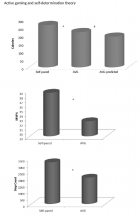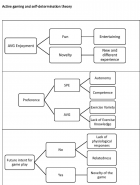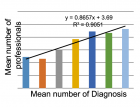Abstract
Research Article
Active gaming and self-paced exercise: A self-determination perspective
Danielle D Wadsworth*, Colleen M Daly and Shelby J Foote
Published: 23 March, 2018 | Volume 3 - Issue 2 | Pages: 043-052
Purpose: This study aimed to identify physical activity, enjoyment, and factors for future activity between an active video game (AVG) condition and self-paced exercise (SPE) among college-aged students.
Methods: Thirty college-aged volunteers (age=22±1.68 years) completed 4-45 minute physical activity sessions (2 AVG; 2 self-paced). A survey and a brief structured interview followed.
Results: Overall, participants expended more calories, accumulated more steps, and more physical activity during SPE; however, participants in the AVG condition met daily exercise recommendations. The majority of participants (81%) enjoyed playing the AVG. Autonomy and competence were found as common themes among those who preferred the SPE condition; whereas, lack of knowledge and exercise variety were emergent themes among those who preferred AVG.
Conclusions: This study provides evidence that college students could meet daily exercise recommendations by participating in AVG interventions; although AVGs that provided autonomy and allowed users to demonstrate competence would be preferable.
Read Full Article HTML DOI: 10.29328/journal.jsmt.1001026 Cite this Article Read Full Article PDF
Keywords:
Moderate-to-vigorous physical activity; College students; Autonomy
References
- Wing R, Phelan S. Long-term weight loss maintenance. Am J Clin Nutr. 2005; 82: 222-225. Ref.: https://goo.gl/raK2dd
- Centers for Disease Control and Prevention (CDC). State indicator report on physical activity, 2014. Atlanta, GA: US Department of Health and Human Services. 2014.
- American College Health Association. American College Health Association-National College Health Assessment II: Reference Group Executive Summary Spring 2014. Hanover, MD: American College Health Association; 2014.
- Bray SR, Born HA. Transition to university and vigorous physical activity: Implications for health and psychological well-being. J Am Coll Health. 2004; 52: 181-188. Ref.: https://goo.gl/14R9EP
- The US. National Physical Activity Plan. The US. National Physical Activity Plan: Education Sector. [Cited July 2017] Available from https://goo.gl/6trXpX
- Sanders GJ, Peacock CA, Barkley JE, Gish B, Brock S, et al. Heart Rate and Liking During “Kinect Boxing” Versus “Wii Boxing”: The Potential for Enjoyable Vigorous Physical Activity Videogames. Games for Health Journal. 2015; 4: 265-270. Ref.: https://goo.gl/Be2LPz
- Maloney AE, T. Carter Bethea Kristine S. Kelsey Julie T. Marks Sadye Paez, et al. A pilot of a video game (DDR) to promote physical activity and decrease sedentary screen time. 2008; 16: 2074-2080. Ref.: https://goo.gl/LeWNvg
- McDougall J, Duncan MJ. Children, video games and physical activity: An exploratory study. International Journal on Disability and Human Development. 2008; 7: 89-94. Ref.: https://goo.gl/41vMZb
- Peng W, Lin J, Crouse J. Is playing exergames really exercising? A meta-analysis of energy expenditure in active video games. Cyberpsychology, Behavior, and Social Networking. 2011; 14: 681-688. Ref.: https://goo.gl/7YoQ71
- Chen G. Effects of exergaming and the physical education curriculum. J Sport Health Sci. 2013; 2.
- Barkley JE, Penko A. Physiologic Responses, Perceived Exertion, and Hedonics of Playing a Physical Interactive Video Game Relative to a Sedentary Alternative and Treadmill Walking in Adults. Journal of Exercise Physiology Online. 2009; 12. Ref.: https://goo.gl/TM3MCE
- Graves L, Stratton G, Ridgers ND, Cable NT. Energy expenditure in adolescents playing new generation computer games. Br J Sports Med. 2008; 42: 592-594. Ref.: https://goo.gl/QxYHhY
- Jones S. Let the games begin: Gaming technology and college students| Pew Research Center’s Internet & American Life Project. Pew Research Center’s Internet & American Life Project. 2003.
- Schneider M, Cooper DM. Enjoyment of exercise moderates the impact of a school-based physical activity intervention. Int J Behav Nutr Phys Act. 2011; 8: 64. Ref.: https://goo.gl/WsgRsZ
- Teixeira PJ, Carraca EV, Markland D, Silva M, Ryan RM. Exercise, physical activity, and self-determination theory: a systematic review. Int J Behav Nutr Phys Act. 2012; 9: 78. Ref.: https://goo.gl/zeUpCE
- Ryan RM, Rigby CS, Przybylski A. The motivational pull of video games: A self-determination theory approach. Motivation and emotion. 2006; 30: 344-360. Ref.: https://goo.gl/DPPHxk
- Wadsworth DD, Foote S. Gaming and Physical Activity: A self-directed approach. In: Gaming: Trends, Perspectives and Impact on Health. New York: Nova Science Publishers 2016.
- Straker LM, et al. Efficient and Effective Change Principles in Active Videogames. Games for Health Journal. 2015; 4: 43-52. Ref.: https://goo.gl/bYcWce
- Deci EL, Ryan RM. Handbook of self-determination research. University Rochester Press. 2002.
- Ryan RM, Frederick C, Lepes D, Rubio N, Sheldon K. Intrinsic motivation and exercise adherence. Int J Sport Psychol. 1997; 28: 335-354. Ref.: https://goo.gl/NR14Gv
- Van Nguyen H, Huang HC, Wong MK, Lu J, Huang WF, et al. Double-edged sword: The effect of exergaming on other forms of exercise; a randomized controlled trial using the self-categorization theory. Computers in Human Behavior. 2016; 62: 590-593. Ref.: https://goo.gl/AtFrUY
- Canadian Society for Exercise Physiology. (2002). PAR-Q & You. https://goo.gl/BdtkQy
- Borg G. Borg's perceived exertion and pain scales. Human kinetics. 1998.
- Welk GJ, McClain JJ, Eisenmann JC, Wickel EE. Field validation of the MTI Actigraph and BodyMedia armband monitor using the IDEEA monitor. Obesity. 2007; 15: 918-928. Ref.: https://goo.gl/2vnWJN
- Ritchie J, Lewis J, Nicholls CM, Ormston R, editors. Qualitative research practice: A guide for social science students and researchers. Sage. 2013.
- Miyachi M, Yamamoto K, Ohkawara K, Tanaka S. METs in adults while playing active video games: a metabolic chamber study. Med Sci Sports Exerc. 2010; 42: 1149-1153. Ref.: https://goo.gl/qBvGjx
- Lanningham-Foster L, Foster RC, McCrady SK, Jensen TB, Mitre N, et al. Activity-promoting video games and increased energy expenditure. J Pediatr. 2009; 154: 819-823. Ref.: https://goo.gl/HWcx4L
- Weaver JB, Mays D, Weaver SS, Kannenberg W, Hopkins GL, wet al. Health risk correlates of video-game playing among adults. Am J Prev Med. 2009; 37: 299-305. Ref.: https://goo.gl/CCSE6M
Figures:

Figure 1

Figure 2

Figure 3
Similar Articles
-
Active gaming and self-paced exercise: A self-determination perspectiveDanielle D Wadsworth*,Colleen M Daly,Shelby J Foote. Active gaming and self-paced exercise: A self-determination perspective. . 2018 doi: 10.29328/journal.jsmt.1001026; 3: 043-052
Recently Viewed
-
FITT-CORRECT: Updated dynamic and evidence-based principle of exercise prescriptionShambhu P Adhikari*,Jarugool Tretriluxana,Rubee Dev,Emily Eglitis,Nistha Shrestha,Cheryl Kerfeld6. FITT-CORRECT: Updated dynamic and evidence-based principle of exercise prescription. J Nov Physiother Rehabil. 2021: doi: 10.29328/journal.jnpr.1001039; 5: 005-009
-
Unusual cause of parietal thoracic pain: A case reportMohamed Labied*,Hayat Lhajoui,Najwa Touil,Omar Kacimi,Nabil Chikhaoui . Unusual cause of parietal thoracic pain: A case report. Arch Case Rep. 2020: doi: 10.29328/journal.acr.1001040; 4: 046-047
-
Zn2+ Ions-Immune Virucidal activities for children and adults with preventions against 2019-nCoV and COVID-19 infectionTsuneo Ishida*. Zn2+ Ions-Immune Virucidal activities for children and adults with preventions against 2019-nCoV and COVID-19 infection. J Child Adult Vaccines Immunol. 2020: doi: 10.29328/journal.jcavi.1001006; 4: 006-014
-
Exophthalmos Revealing a Spheno Temporo Orbital MeningiomaHassina S*, Krichene MA, Hazil Z, Bekkar B, Hasnaoui I, Robbana L, Bardi S, Akkanour Y, Serghini L, Abdallah EL. Exophthalmos Revealing a Spheno Temporo Orbital Meningioma. Int J Clin Exp Ophthalmol. 2024: doi: 10.29328/journal.ijceo.1001055; 8: 001-003
-
Unveiling the Impostor: Pulmonary Embolism Presenting as Pneumonia: A Case Report and Literature ReviewSaahil Kumar,Karuna Sree Alwa*,Mahesh Babu Vemuri,Anumola Gandhi Ganesh Gupta,Nuthan Vallapudasu,Sunitha Geddada. Unveiling the Impostor: Pulmonary Embolism Presenting as Pneumonia: A Case Report and Literature Review. J Pulmonol Respir Res. 2025: doi: 10.29328/journal.jprr.1001065; 9: 001-005
Most Viewed
-
Evaluation of Biostimulants Based on Recovered Protein Hydrolysates from Animal By-products as Plant Growth EnhancersH Pérez-Aguilar*, M Lacruz-Asaro, F Arán-Ais. Evaluation of Biostimulants Based on Recovered Protein Hydrolysates from Animal By-products as Plant Growth Enhancers. J Plant Sci Phytopathol. 2023 doi: 10.29328/journal.jpsp.1001104; 7: 042-047
-
Sinonasal Myxoma Extending into the Orbit in a 4-Year Old: A Case PresentationJulian A Purrinos*, Ramzi Younis. Sinonasal Myxoma Extending into the Orbit in a 4-Year Old: A Case Presentation. Arch Case Rep. 2024 doi: 10.29328/journal.acr.1001099; 8: 075-077
-
Feasibility study of magnetic sensing for detecting single-neuron action potentialsDenis Tonini,Kai Wu,Renata Saha,Jian-Ping Wang*. Feasibility study of magnetic sensing for detecting single-neuron action potentials. Ann Biomed Sci Eng. 2022 doi: 10.29328/journal.abse.1001018; 6: 019-029
-
Physical activity can change the physiological and psychological circumstances during COVID-19 pandemic: A narrative reviewKhashayar Maroufi*. Physical activity can change the physiological and psychological circumstances during COVID-19 pandemic: A narrative review. J Sports Med Ther. 2021 doi: 10.29328/journal.jsmt.1001051; 6: 001-007
-
Pediatric Dysgerminoma: Unveiling a Rare Ovarian TumorFaten Limaiem*, Khalil Saffar, Ahmed Halouani. Pediatric Dysgerminoma: Unveiling a Rare Ovarian Tumor. Arch Case Rep. 2024 doi: 10.29328/journal.acr.1001087; 8: 010-013

HSPI: We're glad you're here. Please click "create a new Query" if you are a new visitor to our website and need further information from us.
If you are already a member of our network and need to keep track of any developments regarding a question you have already submitted, click "take me to my Query."























































































































































